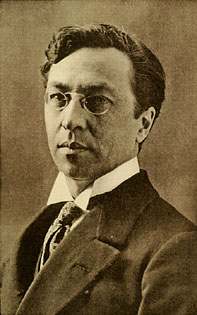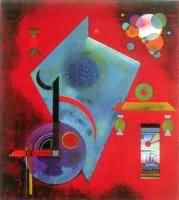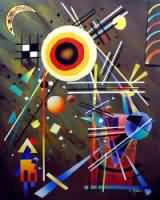Famous Artists
| Paul Cezanne | Salvador Dali | Renoir | Wassily Kandinsky | Joan Miro | Tamara de Lempicka |
| Claude Monet | Gauguin Paul | Picasso | Botero Fernando | Van Gogh | William Bouguereau |
| Wassily Kandinsky (Russian: 圾忘扼我抖我抄 妞忘扶忱我扶扼抗我抄, first name
pronounced as [vassi:li]) (December 16 [O.S. December 4] 1866 每 December
13, 1944) was a Russian painter, printmaker and art theorist. One of the
most famous 20th-century artists, he is credited with painting the first
modern abstract works. Born in Moscow, Kandinsky spent his childhood in Odessa. As a young man he enrolled at the University of Moscow and chose to study law and economics. Quite successful in his profession〞he was offered a professorship (chair of Roman Law) at the University of Dorpat〞he started painting studies (life- drawing, sketching and anatomy) at the age of 30. In 1896 he settled in Munich and studied first in the private school of Anton Abe and then at the Academy of Fine Arts, Munich. He went back to Moscow in 1914 after World War I started. He was unsympathetic to the official theories on art in Moscow and returned to Germany in 1921. There he taught at the Bauhaus school of art and architecture from 1922 until the Nazis closed it in 1933. He then moved to France where he lived the rest of his life, and became a French citizen in 1939. He died at Neuilly-sur-Seine in 1944. Kandinsky's creation of purely abstract work followed a long period of development and maturation of intense theoretical thought based on his personal artistic experiences. He called this devotion to inner beauty, fervor of spirit, and deep spiritual desire inner necessity, which was a central aspect of his art. Kandinsky learned from a variety of sources during his youth and life in Moscow. Later in his life, he would recall being fascinated and unusually stimulated by color as a child. The fascination with color symbolism and psychology continued as he grew, although he seems to have made no attempt to study art. In 1889 he was part of an ethnographic research group that travelled to the Vologda region north of Moscow. In Looks on the Past he relates that the houses and churches were decorated with such shimmering colors that, upon entering them, he had the impression that he was moving into a painting. The experience and his study of the folk art in the region, in particular the use of bright colors on a dark background, was reflected in much his early work. A few years later, he first related the act of painting to creating music in the manner for which he would later become noted and wrote, "Color is the keyboard, the eyes are the hammer, the soul is the piano with the strings." It was not until 1896, at the age of 30, that Kandinsky gave up a promising career teaching law and economics to enroll in art school in Munich. He was not immediately granted admission in Munich and began learning art on his own. Also in 1896, prior to leaving Moscow, he saw an exhibit of paintings by Monet and was particularly taken with the famous impressionistic Haystacks which, to him, had a powerful sense of color almost independent of the objects themselves. Later he would write about this experience: "That it was a haystack the catalogue informed me. I could not recognize it. This non-recognization was painful to me. I considered that the painter had no right to paint indistinctly. I dully felt that the object of the painting was missing. And I noticed with surprise and confusion that the picture not only gripped me, but impressed itself ineradicably on my memory. Painting took on a fairy-tale power and splendour. " He was similarly influenced during this period by Richard Wagner's Lohengrin which, he felt, pushed the limits of music and melody beyond standard lyricism. Kandinsky was also spiritually influenced by H. P. Blavatsky (1831每1891), the most important exponent of Theosophy in modern times. Theosophical theory postulates that creation is a geometrical progression, beginning with a single point. The creative aspect of the forms is expressed by the descending series of circles, triangles, and squares. Kandinsky's book Concerning the Spiritual In Art (1910) and Point and Line to Plane (1926) echoed this basic Theosophical tenet. |
Copyright © XIAMEN DOOYI IMP.& EXP.CO.LTD
Address: 3/F NO.33 NAN PIAN, SHI TANG CUN HAI CANG QU, XIAMEN CHINA Postcode: 361026
Tel: 0086-592-6516557 Fax: 0086-592-6516857 MSN: oilpainting0001@gmail.com
Email: oilpainting0001@gmail.com



